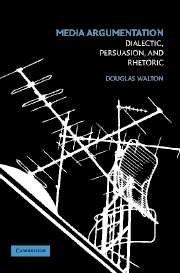Book contents
- Frontmatter
- Contents
- Acknowledgments
- Introduction
- 1 Logic, Dialectic, and Rhetoric
- 2 The Speech Act of Persuasion
- 3 Propaganda
- 4 Appeals to Fear and Pity
- 5 Ad Hominem Arguments in Political Discourse
- 6 Arguments Based on Popular Opinion
- 7 Fallacies and Bias in Public Opinion Polling
- 8 Persuasive Definitions and Public Policy Arguments
- 9 The Structure of Media Argumentation
- Bibliography
- Index
- Plate section
7 - Fallacies and Bias in Public Opinion Polling
Published online by Cambridge University Press: 05 June 2012
- Frontmatter
- Contents
- Acknowledgments
- Introduction
- 1 Logic, Dialectic, and Rhetoric
- 2 The Speech Act of Persuasion
- 3 Propaganda
- 4 Appeals to Fear and Pity
- 5 Ad Hominem Arguments in Political Discourse
- 6 Arguments Based on Popular Opinion
- 7 Fallacies and Bias in Public Opinion Polling
- 8 Persuasive Definitions and Public Policy Arguments
- 9 The Structure of Media Argumentation
- Bibliography
- Index
- Plate section
Summary
Social statistics are needed to conduct intelligent public deliberations and set social policies in a democracy. But activists, the media, and private agencies can and often do use “mutant statistics” as tactics to manipulate public opinion. They can and often do convince people that even the most implausible claims are true by twisting the question wording in a poll (Best 2001, p. 4). But if such polls are based on scientific statistical methods, how is it that their results can be deceptive, misleading, and even deployed fallaciously to support bad arguments? One of the main problems is the use of natural language questions in the polls, containing words and phrases that have emotive connotations that subtly lead respondents toward one answer or away from another (Campbell 1974). This spin factor introduced by the wording of a question is not measured by any indicator of the numerical reliability of the poll typically published alongside the poll findings (Clark and Schober 1992). It is widely recognized that there are biases in scientifically accurate poll results due to the wording of questions used, and that inferences drawn from these biased polls can often be fallacious (Pinto, Blair, and Parr 1993). Critics such as Warnke (1990) and Crossen (1994) have pointed out that exploiting biased language deceptively to twist poll results in a desired direction has become a widely used technique in advertising, cause advocacy, and political push polls.
- Type
- Chapter
- Information
- Media ArgumentationDialectic, Persuasion and Rhetoric, pp. 228 - 274Publisher: Cambridge University PressPrint publication year: 2007



